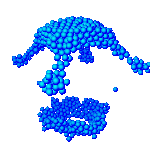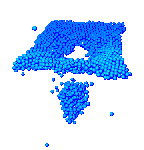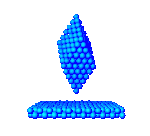|
- The main goal
- Simulation of the micro and macroscopic properties of materials
using Molecular Dynamics and Particle Dynamics methods.
- Head of laboratory
- Prof. Anton
M. Krivtsov.
Institute for Problems in Mechanical Engineering RAS,
St. Petersburg, Russia.
Phone: +7-812-3277144,
E-mail: 
- Members
- Aristovich
K.Y., Former member, London City University, Great Britain.
- Berinskiy
I.E., Ph.D. student, IPME RAS, St. Petersburg, Russia.
- Gilabert
F.A., Former Member, University of Seville, Spain.
- Gonin
O.G., Former member, St. Petersburg, Russia.
- Efimov
A.A., Ph.D. student, IPME RAS, St. Petersburg, Russia.
- Le-Zaharov
A.S., Ph.D. student, IPME RAS, St. Petersburg, Russia.
- Loboda
O.S., Research Fellow, IPME RAS, St. Petersburg, Russia.
- Kuzkin
V.A., M.Sc. Student, SPbSPU, St. Petersburg, Russia.
- Tkachev
P.V., Ph.D. student, IPME RAS, St. Petersburg, Russia.
- Tsaplin
V.A., Research fellow, IPME RAS, St. Petersburg, Russia.
- Vasilyev
S.V., Research fellow, SPbSPU, St. Petersburg, Russia.
- Volkovets
I.B., Former Member, St. Petersburg, Russia.
|
|
Objectives
- Modeling of the mechanical and thermomechanical properties of
nanostructured materials
- Development of the effective methods for simulating plasticity and
fracture
- Description of the macroscopic properties of materials on the base
of their microscopic structure
|
|
Current research
- Analysis of mechanical properties for nanocrystalline materials
- Computer design of nanomaterilals on the basis of molecular dynamics
approach
- Molecular dynamics analysis of mechanical and thermodynamic
properties of mediums with microstructure
- Computer analysis of the shock wave propagation in polycrystalline
materials
- Microstructure simulation of plasticity and fracture
- Modeling dislocations in crystalline materials
- Microstructure simulation of impact interaction of rigid bodies
|
|
Examples
|
- Background
-
The idea of the Particle Dynamics method is based on
the concept that a material can be modeled by a large number of
interacting particles, described by the classical laws of dynamics.
Interaction between particles is determined by the interparticle
potentials. The main feature of the interparticle potentials is
repulsion at short range and attraction at long range. The initial
conditions including two following components should be set before the
simulation starts: space distribution of the particles (initial
structure of the material) and distribution of the particles velocities
(mechanical and thermal motion of the system in the initial state).
Afterwards the simulation can be performed as a numeric solution of the
Cauchy problem for the system of ordinary differential equations.
One of the best-developed variants of this method is
the Molecular Dynamics. The last decades the Molecular Dynamics method
has been intensively applied for investigation of the physical and
chemical properties of materials. In the classical Molecular Dynamics
the particles represent atoms and molecules. Nowadays the interatomic
potentials for the most important materials are well known, that allows
modeling molecular systems with a high rate of accuracy. The interest to
modeling materials at the nanoscale level was drastically increased
after discovering that materials with the nanoscale structure elements
can possess essentially new mechanical and physical properties.
Considering the current development of the computer techniques the
Molecular Dynamics method allows simulating nearly any nanostructures
with the highest level of accuracy. That is why this method has become
the main computational method for the nanotechnologies.
For modeling materials at the macroscopic scale level,
of course, it is impossible to leave the molecular concept as such. In
this case particles should represent elements of the higher scale level
(mesolevel), for example the level of material grains. Last years this
approach appears to be an important alternative for the continuum
mechanics in modeling plasticity and fracture. Following the tradition,
this method frequently is called Molecular Dynamics, but more accurate
name is Mesoparticle Dynamics or simply Particle dynamics. The important
advantage of this method is that it needs far less a priori assumptions
for the material properties. Indeed, even a simple Lennard-Jones
potential allows simulating such complicated properties as plasticity,
crack appearance, fracture, phase transitions, and thermomechanic
behavior of materials. Each of these phenomena needs separate theory in
the framework of the continuum mechanics. On contrary, Particle Dynamics
method allows to obtain these effects almost automatically, while
integrating equations of motion for each particle. In particular,
irreversibility for the mechanical processes is achieving by transition
of the long-wave mechanical energy to the thermal energy of the chaotic
motion of the particles.
Interaction potential plays in the Particle Dynamics
the same role as the constitutive equations in the continuum mechanics.
But the structure of the interaction potential is far simpler, since the
potential is a scalar function of a single variable ? the interparticle
distance, while the constitutive equations are operators from tensor
characteristics of the strain, and also they depend on the thermodynamic
quantities. The particular shape of the interaction potential can be
obtained from the comparison between macroscopic properties of the
computer material and the real material. For the simplest (elastic,
thermoelastic and some plastic) properties this comparison can be done
analytically. In other cases the correspondence can be obtained from the
computer experiments. |
- Methods
-
The group has developed original methodic for Particle
Dynamics simulation. Modeling includes
- Preparing the initial configuration: setting the macroscopic
shape, inner structure, macroscopic velocities, and microscopic
(thermal) velocity fields.
- Simulation of the system dynamics (solving equations of motion)
and recording the control and statistical parameters.
- Analysis of the data obtained during the computer experiment.
The program package for solving these tasks is
developed. The main advantages of the software are convenience for
setting the initial parameters, high efficiency of the numeric
algorithms, and visualization of the modeling using advanced 3D computer
graphics.
The main distinctions for the Particle Dynamics methods being
developed by our group are
- Use of polycrystal particle arrangements.
- Account of the moment interaction and rotation energy for the
particles.
- Optimized algorithms allowing simulating systems containing up to
millions particles on simple personal computers.
For the large-scale computations the group is using the resources of
the Joint Supercomputer
Center. |




